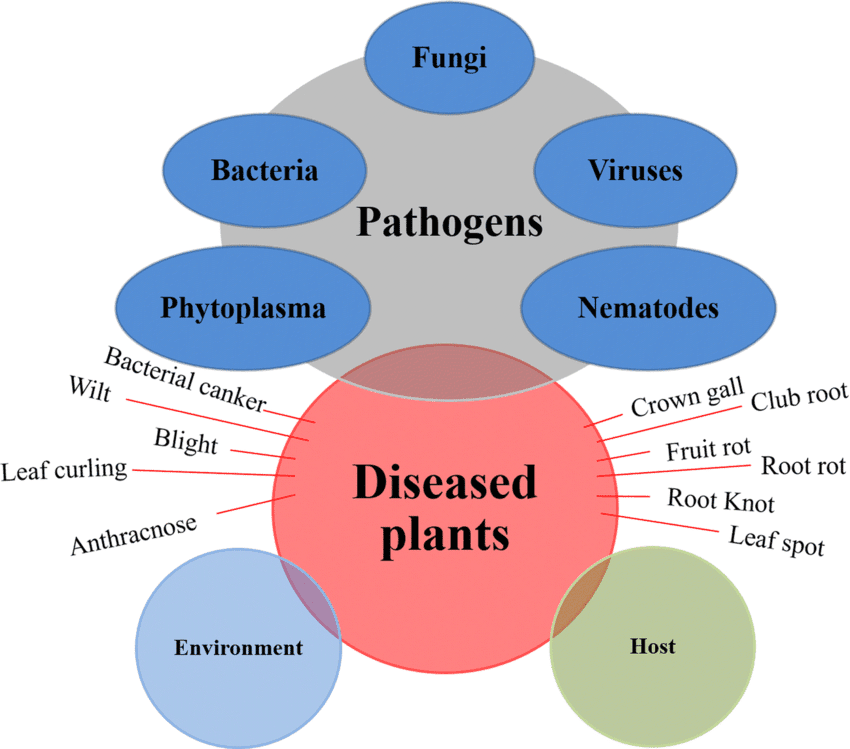Unveiling the Layers: A Comprehensive Exploration of the Causes of Plant Diseases
- Pathogens:
- Fungi:
- Invasion
Strategies: Fungi employ various strategies for entry, including
penetration through stomata, wounds, and aerial spore dispersal.
- Impact
on Plants: Different fungal species exhibit host specificity,
causing diseases like powdery mildew, damping-off, and anthracnose.
- Bacteria:
- Intricacies
of Infection: Bacterial pathogens often utilize wounds or natural
openings to invade plant tissues, compromising cellular integrity.
- Disease
Spectrum: From soft rots to bacterial cankers, the effects of
bacterial infections are diverse and depend on the specific pathogen
involved.
- Viruses:
- Transmission
Dynamics: Vectors like aphids, whiteflies, and leafhoppers play a
crucial role in the transmission of viral diseases.
- Genetic
Complexity: Viruses exhibit high mutation rates, contributing to the
challenge of developing resistant plant varieties.
- Nematodes:
- Subterranean
Threats: Nematodes, with their microscopic size, infiltrate plant
roots, disrupting nutrient uptake and creating an entry point for other
pathogens.
- Cyst
and Root-Knot Nematodes: Different types of nematodes cause distinct
diseases, affecting plant growth and productivity.
- Environmental
Factors:
- Abiotic
Stress:
- Drought
Dynamics: Beyond water scarcity, drought stress triggers hormonal
changes in plants, making them more susceptible to diseases.
- Oversaturation
Challenges: Waterlogged conditions provide an ideal breeding ground
for fungi, causing root diseases and compromising plant vitality.
- Temperature
Extremes:
- Heat-Induced
Vulnerability: High temperatures weaken plant defenses, while
extreme cold can lead to freeze-related injuries and secondary
infections.
- Pathogen
Proliferation: Temperature fluctuations impact the life cycles of
pathogens, affecting disease prevalence.
- Soil
Conditions:
- Nutrient
Imbalances: Soil pH, nutrient deficiencies, and excesses influence
plant health, shaping their resistance or susceptibility to diseases.
- Persistence
of Soil-Borne Pathogens: Some pathogens exhibit resilience in
specific soil conditions, necessitating strategic management practices.
- Host
Susceptibility:
- Genetic
Factors:
- Resistant
Cultivars: Breeding programs aim to develop plant varieties with
enhanced resistance to specific diseases, reducing reliance on chemical
interventions.
- Disease
Resistance Genes: Identification and incorporation of resistance
genes contribute to the development of robust and resilient crops.
- Age
of the Plant:
- Youthful
Vulnerability: Young plants may lack a fully developed defense
system, making them susceptible to a range of diseases.
- Senescence
Challenges: Aging plants face challenges in maintaining robust
defense mechanisms, increasing their susceptibility to infections.
- Human
Activities:
- Cultural
Practices:
- Crop
Rotation Strategies: Proper crop rotation disrupts the life cycles
of soil-borne pathogens, minimizing their prevalence.
- Dense
Planting Issues: Overcrowded planting creates a microenvironment
conducive to disease spread, necessitating proper spacing and
monitoring.
- Transportation
of Pathogens:
- Biosecurity
Measures: Adherence to strict quarantine measures and regulations is
vital to prevent the introduction and spread of exotic pathogens.
- Human-Mediated
Dissemination: Human activities, including the movement of infected
plant materials and tools, contribute to the geographic spread of
diseases.
The causes of plant diseases unravel as a tapestry woven with threads of pathogens, environmental dynamics, host susceptibility, and human interventions. A profound understanding of these intricacies equips growers with the knowledge needed to implement targeted and sustainable disease management strategies. From molecular interactions to macroscopic environmental influences, the layered exploration of plant disease causes offers a comprehensive perspective for cultivating resilient and thriving agricultural ecosystems.
Frequently Asked Questions (FAQs) about Causes of Plant Diseases
1. Q:
What are the main types of pathogens that cause plant diseases?
A: The
primary pathogens include fungi, bacteria, viruses, and nematodes. Each group
has specific characteristics and modes of infection affecting plants
differently.
2. Q:
How do fungi invade plants, and what diseases do they cause?
A: Fungi can
enter through wounds, stomata, or airborne spores. They cause diseases such as
powdery mildew, damping-off, and rusts, affecting various plant parts.
3. Q:
What role do bacteria play in plant diseases, and how do they infect plants?
A: Bacteria
invade plants through wounds or natural openings, causing diseases like
bacterial canker, soft rots, and blights.
4. Q:
How are viruses transmitted to plants, and what are their effects?
A: Viruses
are often transmitted by vectors like aphids and whiteflies. They lead to
distorted growth, mottled leaves, and reduced plant vigor.
5. Q:
What is the significance of nematodes in plant diseases, and how do they attack
plants?
A: Nematodes
infiltrate plant roots, disrupting nutrient uptake and creating entry points
for other pathogens. Cyst and root-knot nematodes cause distinct diseases.
6. Q:
What environmental factors contribute to plant diseases?
A: Abiotic
stress such as drought, oversaturation, temperature extremes, and soil
conditions influence plant health, making them more susceptible to diseases.
7. Q:
How can soil conditions affect plant diseases, and what are some examples?
A: Soil
conditions, including pH, nutrient imbalances, and specific pathogen
persistence, impact plant health. For instance, imbalances may lead to nutrient
deficiencies, affecting disease resistance.
8. Q:
What role does host susceptibility play in plant diseases?
A: Host
susceptibility is influenced by genetic factors and the age of the plant.
Breeding programs aim to develop resistant cultivars, while young and old
plants may exhibit vulnerability.
9. Q:
How do human activities contribute to plant diseases?
A: Cultural
practices like crop rotation and spacing influence disease prevalence.
Human-mediated transportation of pathogens through infected materials or tools
also contributes to disease spread.
10. Q:
How can growers prevent the spread of plant diseases?
A:
Preventive measures include implementing proper crop rotation, spacing, and
adhering to biosecurity measures. Strict quarantine regulations and monitoring
tools for human-mediated spread are crucial.
11. Q:
What are the consequences of environmental stressors on plant diseases?
A:
Environmental stressors weaken plants, making them more susceptible to
diseases. This can include hormonal changes triggered by drought,
oversaturation, or extreme temperatures.
12. Q:
Are there specific strategies for developing disease-resistant crops?
A: Yes,
breeding programs focus on identifying and incorporating disease resistance
genes to develop cultivars with enhanced resistance to specific pathogens.





.jpg)
0 Comments